 Overview
Overview
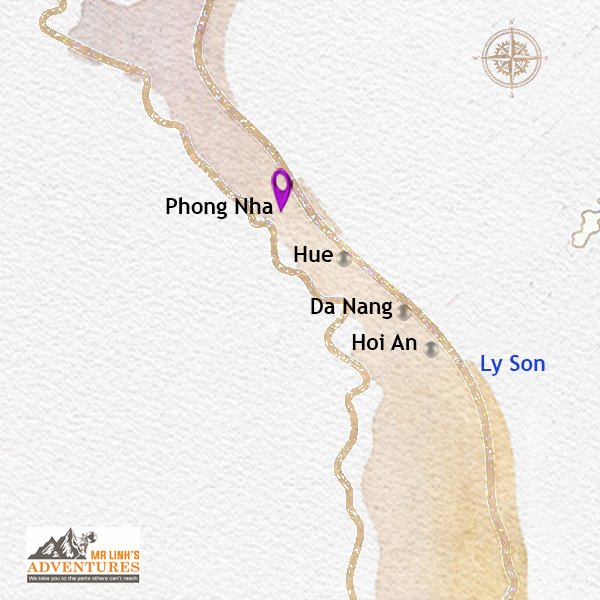
The result of 400 million years of formation, erosion, and tectonic movements, the
Phong Nha-Ke Bang Park is home to one of the most astonishing cave systems on the planet.
A labyrinth of more than 100 km, where nature has displayed treasures of creativity: monumental stalactites and stalagmites, peaceful pools, sinuous rivers, and caves of colossal dimensions, capable of rivaling the largest metropolises.
 Top Attractions
Top Attractions
Adventure Awaits in Pygmy Cave, Phong Nha - Ke Bang - Mr Linh's Adventures Customers
In Phong Nha-Ke Bang National Park, there are caves, but not just!
Phong Nha Cave
Extending nearly 8 kilometers, this underground marvel is explored by boat, offering a breathtaking sight of rock formations sculpted by time.
Paradise Cave (Thien Duong)
With its 31 kilometers of galleries, it ranks as the longest dry cave in Asia. The ascent of its 500 steps is rewarded with the vision of stalactites and stalagmites of rare beauty.
Chay River and Dark Cave
Chay River provides refreshing moments with swimming and mud baths, while Dark Cave offers thrilling adventures in kayaking and zip-lining.
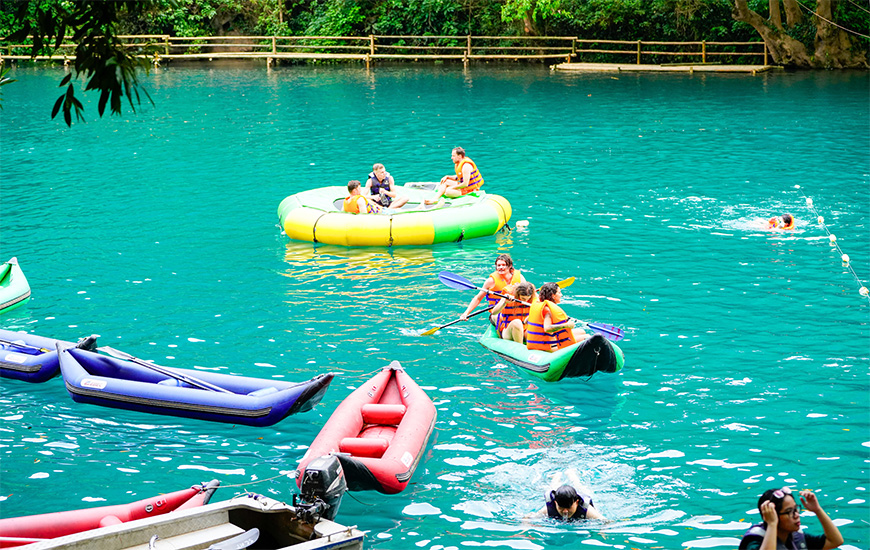 Chay River & Dark Cave, A Thrill-Seeker’s Dream - Mr Linh's Adventures
Chay River & Dark Cave, A Thrill-Seeker’s Dream - Mr Linh's Adventures
Botanical Garden and Thac Gio (Windy Waterfall)
This peaceful haven shelters exceptional biodiversity, with nearly 500 tree species and a majestic 30-meter waterfall, inviting relaxation and discovery.
 See & Do
See & Do
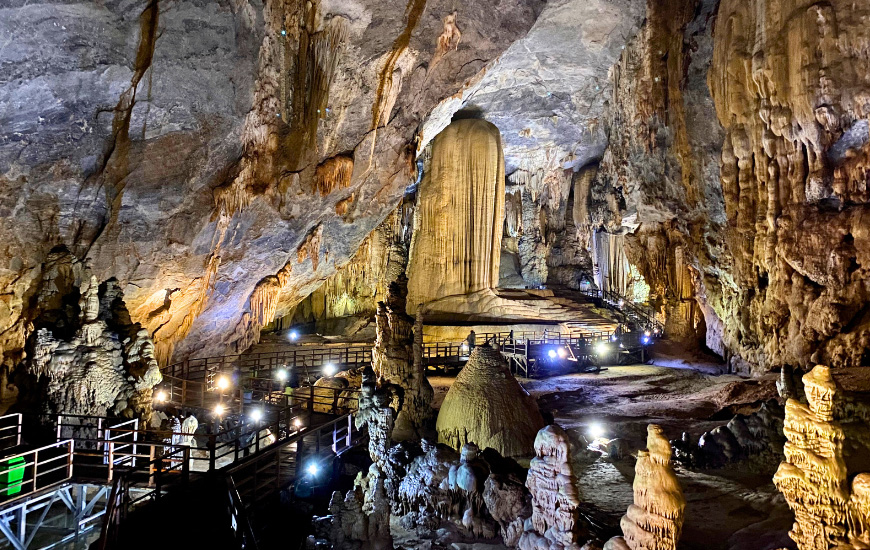 Exploring Paradise Cave - Mr Linh's Adventures
Exploring Paradise Cave - Mr Linh's Adventures
Phong Nha-Ke Bang National Park is a place of exceptional beauty, a
UNESCO World Heritage site.
It houses an
extensive network of underground caves, including the world's largest,
Son Doong, discovered in 2009. These caves, sculpted by millions of years of erosion, offer a grand spectacle with their stalactites, stalagmites, and underground rivers. While some areas of Phong Nha-Ke Bang National Park are still inaccessible, the parts open to exploration offer an unforgettable experience. The beauty of another world unfolds through the caves and forests that make up this exceptional ecosystem.

Beneath the Surface, Exploring Phong Nha’s Mysterious Caves - Mr Linh's Adventures Customers
To break away from the caves, the Phong Nha Botanical Garden is a fantastic place to admire the beauty above ground. The rich natural forest boasts a fascinating variety of wildlife and flora, both wild and in the wildlife sanctuary. The journey through the park stops at the picturesque Thac Gio waterfall and the peaceful Vang Anh Lake.
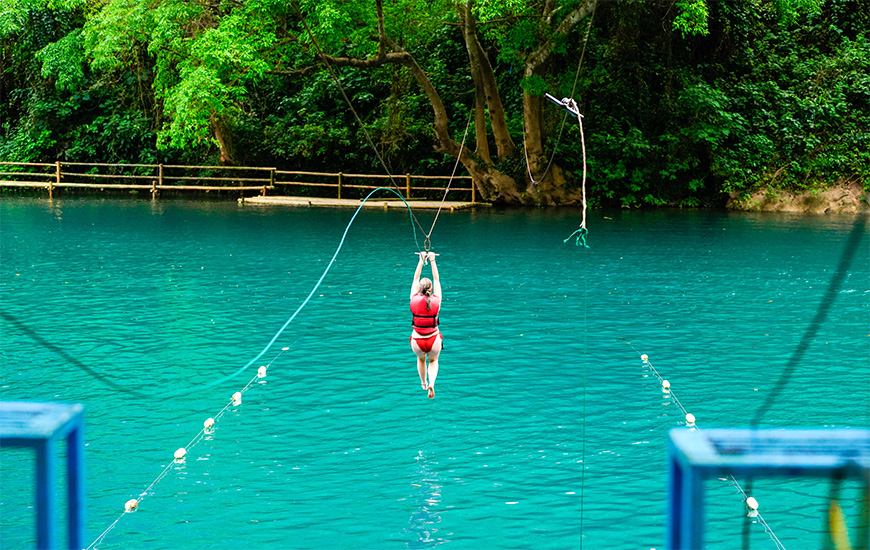 Ziplining in the Dark Cave Site - Mr Linh's Adventures
Ziplining in the Dark Cave Site - Mr Linh's Adventures
Phong Nha-Ke Bang is an ideal playground for adventurers. On the agenda:
Hiking and trekking: Trails through the park's jungle, to discover landscapes of pristine beauty.
Kayaking and swimming: Crystal-clear underground rivers, for a refreshing experience.
Zip-lining and obstacle courses: Playful activities for the whole family.
Caving: Caves of all levels, for beginners and experts alike.
 Go Green
Go Green
Mr Linh's Adventures offers tailor-made tours for a total immersion in the Phong Nha region:
Cave expeditions: Personalized adventures to discover the secrets of Phong Nha's caves.
Jungle trekking: Off-the-beaten-path hikes for an authentic connection with nature.
Encounters with local communities: Sharing experiences to discover the culture and traditions of the region.
 Heritage
Heritage
Bru-Van Kieu People
Local Communities
Phong Nha-Ke Bang is home to several ethnic groups, mainly:
The Chut
A minority ethnic group with various subgroups, such as Sach, May, Ruc, and A Rem. The A Rem live within the national park itself.
The Chut - whose name means "rock cave", referring to their ancient shelters - have settled in the districts of Bo Trach and Quang Trach in Quang Binh province for over 500 years. Historically, they were pushed into the mountains due to wars and high taxes. They speak dialects belonging to the Viet-Muong linguistic group, a branch of Austro-Asiatic languages. The Arem subgroup speaks the Arem language. They have a rich folklore tradition that includes chants like Ka-tum and Ka-lenh.
The Van Kieu (Bru-Van Kieu)
The Bru are part of the Bru-Van Kieu ethnic group, a fascinating community known for its unique traditions, rich history, and captivating culture.
Several subgroups are counted, such as Van Kieu, Khua, Ma Coong, and Tri. The Ma Coong have a notable presence in the region, with cultural festivals like the Macoong drum festival. The Van Kieu speak the Bru language, which belongs to the Mon-Khmer linguistic family, close to the Ta Oi and Co Tu languages. Folk singing is popular, especially the "cha chap" (sung stories) and "sim," a chant alternating between young men and women.
Historical Sites
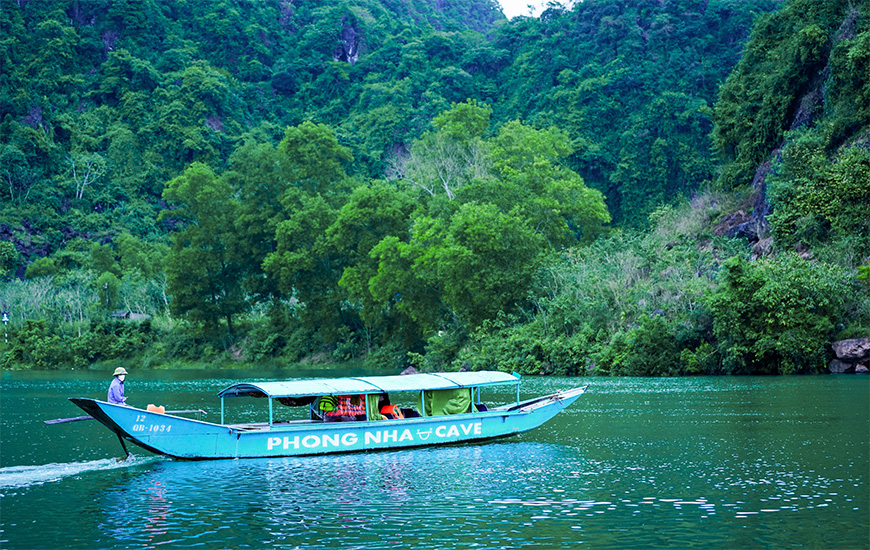 Phong Nha Cave Adventure, Scenic Boat Ride and Hike - Mr Linh's Adventures
Phong Nha Cave Adventure, Scenic Boat Ride and Hike - Mr Linh's Adventures
Phong Nha-Ke Bang is also a place steeped in history, with traces of human occupation dating back to the Cham period. The region has witnessed significant events, especially during the Vietnam War.
At the gates of Phong Nha, a strategic crossroads, a convergence point of three routes, testifies to the region's crucial role during the Vietnam War. The East Ho Chi Minh Trail, the West Ho Chi Minh Trail, and Victory Road 20 were integral parts of the famous Ho Chi Minh Trail, a vital artery for Viet Cong troops, connecting the North and South of the country for the transport of materials and soldiers. But Phong Nha's involvement in the conflict is not limited to this road network. The caves of Phong Nha and nearby cavities served as shelters for troops and supplies. These vast enclosed spaces offered safe havens, and Phong Nha Cave was even transformed into a military hospital. Many local residents joined the Viet Cong ranks, making the region an important stronghold in the fight against South Vietnam and the United States.
This narrowest area of Vietnam (only 42 km wide) was a prime target for the Americans, who sought to cut off the enemy's supply line. After the discovery of hidden caves, bombings intensified, leaving behind scars still visible today: fields dotted with craters and traces at the entrance of some caves. Phong Nha, both a natural haven of peace and a place of memory, bears the marks of a tumultuous past.
 Food & Drinks
Food & Drinks
Quang Binh's gastronomy is an unforgettable culinary experience
Chao Canh, a culinary emblem of Quang Binh, is a symphony of flavors and textures. In a golden broth, rice vermicelli, seafood (shrimp, fish), pork, and spring rolls bathe. Garnished with green onions and aromatic herbs, this comforting dish is a true ode to local gastronomy.
Grilled chicken with Cheo salt, a jewel of Quang Binh's gastronomy, is an unforgettable culinary experience. Its golden skin, tender and fragrant flesh, infused with local spices, seduces the most discerning palates. Cheo salt, a typical condiment of Phong Nha, perfectly enhances the flavors of chicken and grilled meats. A single bite of this exceptional dish is enough to fall in love with it.
Banh Cuon Tom, a unique version of steamed rice rolls, reveals the culinary identity of Quang Binh. While Banh Cuon is a Vietnamese classic, each region reinvents it. Here, the rice cake, of refined simplicity, is accompanied by fresh shrimp, thin slices of cucumber, aromatic herbs, and a flavorful sauce. This apparent simplicity hides an explosion of flavors that seduces even the most demanding palates.
Dried squid salad with mango, another jewel of Quang Binh's gastronomy, is a bold marriage of flavors and textures. The dried, grilled, and finely sliced squid blends with the tangy sweetness of mango, enhanced by the crunch of peanuts and the freshness of aromatic herbs. The soul of this dish lies in its sauce, a perfect balance of sweet, spicy, and tangy, awakening the taste buds and leaving an unforgettable gustatory imprint.
 Directions
Directions
Location
Quang Binh Province, central Vietnam.
How to get there
⇒ From Hanoi: Train or bus (about 10-12 hours), flight (about 1 hour).
⇒ From Ho Chi Minh City: Train or bus (about 24-30 hours), flight (about 1 hour 30 minutes).
Ticket prices vary depending on the mode of transport and the time of year.
Best season
From February to August, for a dry and sunny climate.
Feel free to
contact us to organize your stay in Phong Nha-Ke Bang. We will be delighted to advise you and offer activities and tours tailored to your preferences.